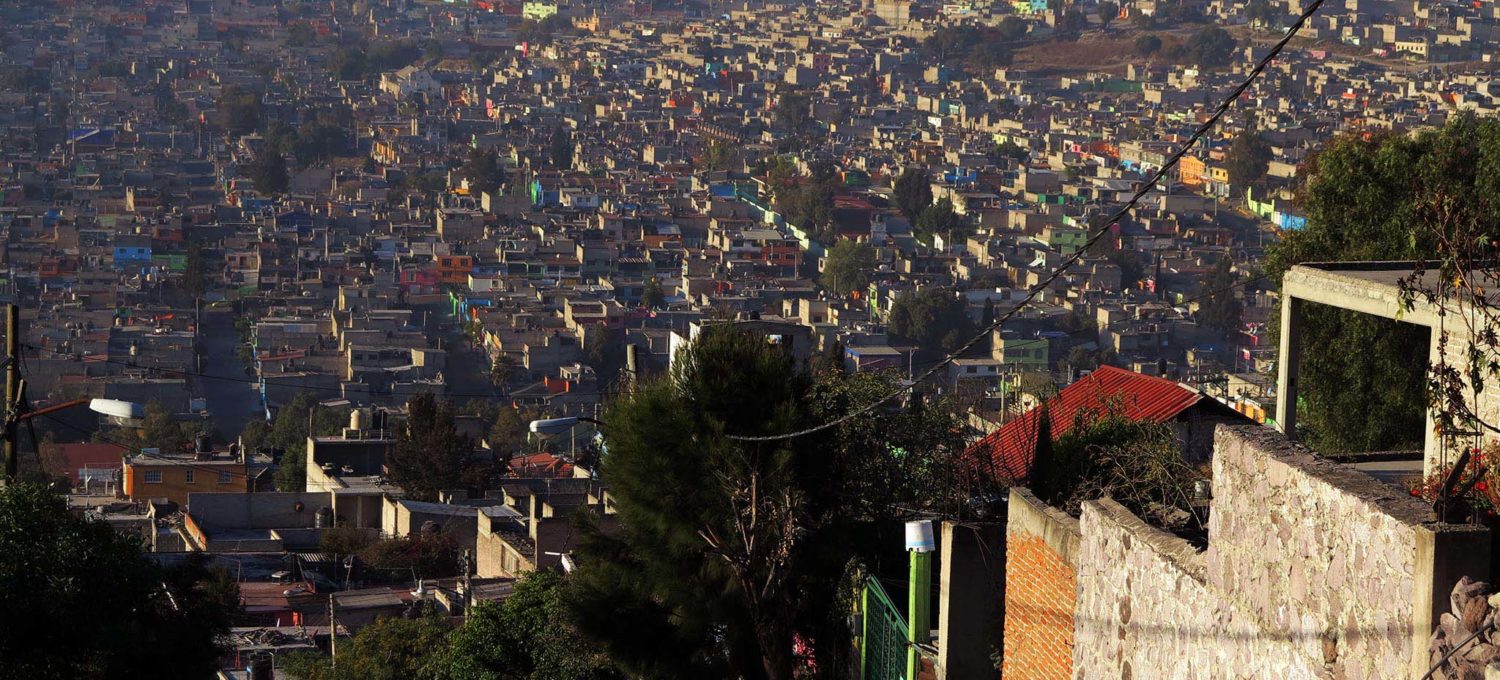In the north of Ecatepec there is a huge spiral, like landscape art, composed of a dike enclosing water basins between its coils. Once it was a plant for the production of soda in the former lakebed of Texcoco. Water would evaporate, sluices would open and eventually white soda was all that would be left. The dike’s spiral itself is hundreds of meters at its widest diameter.
I stood on the elevation of a former landfill, looking at this remarkable mark on the landscape, the city’s tattoo. Scrambling along the slope of the landfill sandwiched between a large housing complex, the spiral and a mall, I reached ground level and continued along the marshy rim of the Lake of Texcoco.
Self-built houses were scattered along the muddy lakebed, often with wide vacant lots between them. The mosquitoes were terrible and a constant nuisance. Sometimes I would see white spots in the dried out mud, attesting to the minerals in the soil. Once the Lake of Texcoco had been salt-water. And you can still tell in the north of the city.
I stopped for a soft drink at a small store with wire mesh in front of the counter. The young man attending me told me he had been living there for five years. It was quiet. He had also grown up on the edge of the city close to Ciudad Azteca. Now that area had been completely urbanized and he had moved with his family to the city’s current edge. Maybe his children when grown up would also build there house somewhere on some future edge of the city.
I continued over the pale dirt roads amid the cinderblock houses. I saw two older men one of whom was walking with a bicycle in hand and carrying tools. I spoke to the maestro albañil – master builder. I asked him how this area had come to be urbanized. The story was familiar. The land had been expropriated from campesinos and sold by an intermediary who was a partner of local politicians. The builder told me that he had lived there for over thirty years now.
He remembered the days when geese and duck still landed on the lakeside. He explained to me how they used to hunt them. The local inhabitants would first scatter corn in the fields. Then they would take a metal tube and fill it with old nails and scraps of metal. To this they would add gunpowder. When a flock of geese descended they would light the gunpowder and the scattershot would leave hundreds of dead geese in the fields, a bonanza.
The birds no longer come. Sometimes it is noted that Mexico City does not really seem to have a regional cuisine. Perhaps it was all duck, goose and fish from the lakes. The local cuisine disappeared with the obliteration of the ingredients.

The most costly part of houses was steel for the reinforced concrete. I asked the builder whether the houses could withstand earthquakes. He said that precisely for that reason pillars had to be built every two meters or so of wall. I attentively made note of the different factors in the construction of a house.
A house becomes a house when it has electricity, a water tank and a septic pit. With these elements in place, inside it could be anywhere. Water will run, the toilets will flush and the television set will glow. The fact that there is no drainage or running water is not really noticeable as far as life within the house is concerned. Water needs to be bought from pipe-trucks to fill the cylindrical, black plastic tanks on the roofs and once every 10 years the septic pit has to be dug out once more. But beyond that connection to the city’s water infrastructure is actually not that important.
On the other hand moving water around in trucks is highly inefficient and costly. The whole point of water is that it flows downhill all by itself. For this reason a well-built house, said the builder, is elevated not so much as to avoid flooding but rather so that water from the drains can flow into the street without backing up.
People learn how to build their own houses. Afterwards they themselves can become masons and builders for other people and so the learning process goes on. The city slowly consolidates, values rise and services arrive. And so Mexico City grows wall-by-wall, house-by-house. And everyone is a builder.
I continued along the non-consolidated rim amidst the half-built grey houses, unpaved avenues and vacant lots. The bare and unpainted appearance belied a neighborhood sprouting up with all the order of time-proven method. Water towers already stood like alien invaders high among the houses.
As the sun lowered toward the west I left this great city spiraling towards its realization and passed to the willow trees and pastures of Atenco. I was cutting into the countryside, headed for Santa Catarina del Monte, home of musicians, for the festivities of Santa Cecilia.
